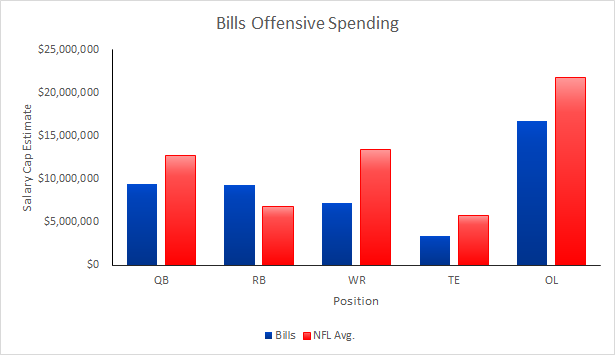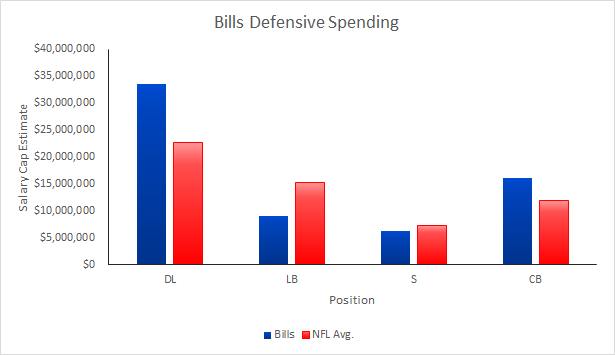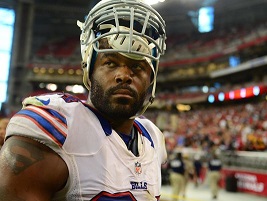Estimated 2015 Cap Space: $22.1M ($140M cap limit)
Roster Overview
Players Under Contract: 62 (Includes Kyle Orton)
Pro Bowlers: 3
Unrestricted Free Agents: 11(4 with 50%+ playtime)
Draft Selection: 19
Salary Cap Breakdown



Free Agents to Re-sign
The top priority for the Bills should be retaining defensive end Jerry Hughes, who has developed into one of the most productive pass rushers in the NFL. Hughes will enter free agency with back to back season of double digit sacks and is versatile enough to play in any defensive scheme. Hughes is a much more productive rusher than Paul Kruger was when he got $8.1 million and Hughes should be pushing for $10+ million. Franchising him is an option…Running back CJ Spiller has issues remaining healthy, but he is a known commodity and since running backs are not expensive it might be worth re-signing him. With Rex Ryan in as head coach one would expect Spiller to get more opportunities than he did in the prior offense…Ryan also likes to load his teams up with defensive backs which could make keeping Da’Norris Searcy an option. He’s versatile and a sound player which should make him a player to keep around. He won’t break the bank to keep him.
Free Agents to Let Walk
Brandon Spikes is one of those old school linebackers that has lost more and more importance in todays NFL. The Bills should have no shortage of players to replace him and Ryan could push for players he is more familiar with to be the teachers of his new defense…Buffalo’s offensive line was a problem all of 2014 which means anyone is fair game to go. With that in mind I am not certain there would be any consideration given to bringing back a 33 year old Eric Pears, at least not until after the draft in the event no replacement is found.
Contracts to Modify
Defensive tackle Marcell Dareus has proven to be the real deal and those players are better locked up sooner rather than later. One thing that you can count on is that Ryan will hype up his players to the point where they end up demanding more from the team. Combining that with a market set to increase with Suh’s free agency it is so much smarter for the Bills to get the deal done before all these things occur…Depending on what goals the Bills have in free agency, there could be some consideration given to working with the contract of Mario Williams. Williams has a cap charge of $19.4 million which they can lower by a few million, but that will just add to an already giant cap charge of $19.9 million in 2016…Kraig Urbik is due $3 million in salary and the team could consider lowering that charge or even releasing him outright if they believe they can find a better player. I would think they would like to keep him only because there are so many questions with the line and spots to fill that he might be the guy to stay.
Players to Consider Releasing
The Bills offensive line should get an overhaul which I believe puts center Eric Wood in danger. Wood was graded poorly by Pro Football Focus and the team may find his $4.85 million salary too high. They would save $1.25 against the cap and could also use June 1 cut, a mechanism the Bills have used in the past. That allows them to spend to the cap limit now and use the full $4.85M savings to pay the draft class…. Releasing linebacker Keith Rivers, who was used sparingly last year, saves the team $1.7 million in cap space….Manny Lawson saw action in about 30% of the teams snaps last season and would save the team $1.6 million if they cut him.
Offseason Plan
The Bills should be an extremely interesting team to watch this offseason. In hiring Rex Ryan they are clearly focusing on winning now with their veteran defense while they hope they can find enough consistent firepower on offense to improve. They have money to spend and the ability to create more if they need to. The question is where do they spend it?
Currently Kyle Orton has yet to officially be placed on the retired list for the Bills. The team continues to hold his rights and his $7.5 million cap figure remains on the books. Orton played the “Im going to retire” card with the Cowboys last season only to change his mind and I have to believe that Ryan would like to convince him to stay. While Orton is limited he is a more proven player than EJ Manuel. If he stays he’ll likely get a raise and if he goes they create $6 million in cap space.
If Orton does maintain his retirement one would expect the Bills to go after a quarterback in free agency. The logical choice would be to go after Mark Sanchez, who knows the AFC East, and played much better in Philadelphia than he did in New York. Bills offensive coordinator Greg Roman was able to completely salvage the career of Alex Smith so the coordinator kind of fits here as well. Sanchez won’t be incredibly expensive- likely in the same $7-9 million range with a chance to earn more that Smith worked on in San Francisco in 2012.
Once they settle on a QB they should focus on the offensive line. They will start with right tackle where they can look at Bryan Bulaga, Joe Barksdale, and Doug Free. Orlando Franklin is a very intriguing option because he’s a known commodity that can play tackle or guard at a high level, giving the team more draft flexibility. A higher end, right tackle likely costs around $6M a season. There will be shortage of centers available with Stefen Wisniewski and Rodney Hudson at the top of the chart. Brian De la Puente may be an affordable option. I believe they need to fill at least two spots in free agency (right tackle and either guard or center depending on the Pears/Urbik decisions).
Running back will be a place where they can find some help for Fred Jackson if they decide to go away from CJ Spiller. The question is would Ryan influence trying to sign a workhorse back (DeMarco Murray) or would they find a lower cost veteran and then pair him with a draft pick? Ryan’s best seasons in New York came with the combo of an older player (Thomas Jones and LaDainian Tomlinson) paired with a younger back (Shonn Greene). If he believes Jackson still has it in him for a full 16 game schedule then expect this to be more of a draft target.
The big question on defense becomes whether or not the Bills get involved with Darrelle Revis, if he becomes a free agent. The team has a good secondary but Revis and Ryan were a tremendous pairing and he would give the Bills one of the best secondaries in the NFL. He’s incredibly expensive but it would be sold as a move that weakens their biggest division rival at the same time it improves the Bills. If you sign Revis you are going to be limited in what you can do elsewhere as this would probably leave the team with two of the top five, possibly top 3, defensive salaries in the entire NFL on the roster. Add in Hughes and you have an insane amount of money invested in the defense. If they do go after Revis it will be difficult to bring in the linemen they desperately need.
If they don’t pursue Revis they should have money to send out feelers for players like Jordan Cameron or David Harris, if Ryan opts to have a voice of a familiar face on his defense. I would expect Ryan to push to sign some of his lower level guys from the Jets to bolster the defensive depth such as Kenrick Ellis or Leger Douzable.
Unfortunately for the Bills they don’t have a first round draft pick so going all in on free agency becomes almost a necessity. They have been willing to do some player friendly contract structures to land big players in the past- Mario Williams’ first year cap charge was under $10 million- so I don’t see the cap being much of a barrier. Being that they have no QB on the roster worth any money, nor any player they could sign worth big money they will be under-invested at that position for the next 4 years at a minimum, giving them reason to overspend on “superunits” elsewhere. I think the plan will be to deal with 2017 cap charges when 2017 comes.
The Bills are really a team to keep an eye on this March. They are going to be one of the lurkers that people don’t expect much out of but may come out of the gates firing. If Orton goes than expect the team to be around $32 million in cap room following cuts. If they work out a new deal for Dareus and convert some of Williams money to a bonus they can push $40 million. The key is getting Hughes signed early because there is no cap relief gained from applying the franchise tag. If they carry him at $13 million it will put a limit on what they can do and quickly eat that space away. My gut feeling is that by the end of free agency there will be a great deal of buzz about the Bills chances in 2015.
Bills Links
Bills Salary Cap Pages
Bills Free Agents
Bills Contracts
Bills GM Salary Cap Calculator
Other Offseason Salary Cap Reports
Bills Free Agent Simulator




